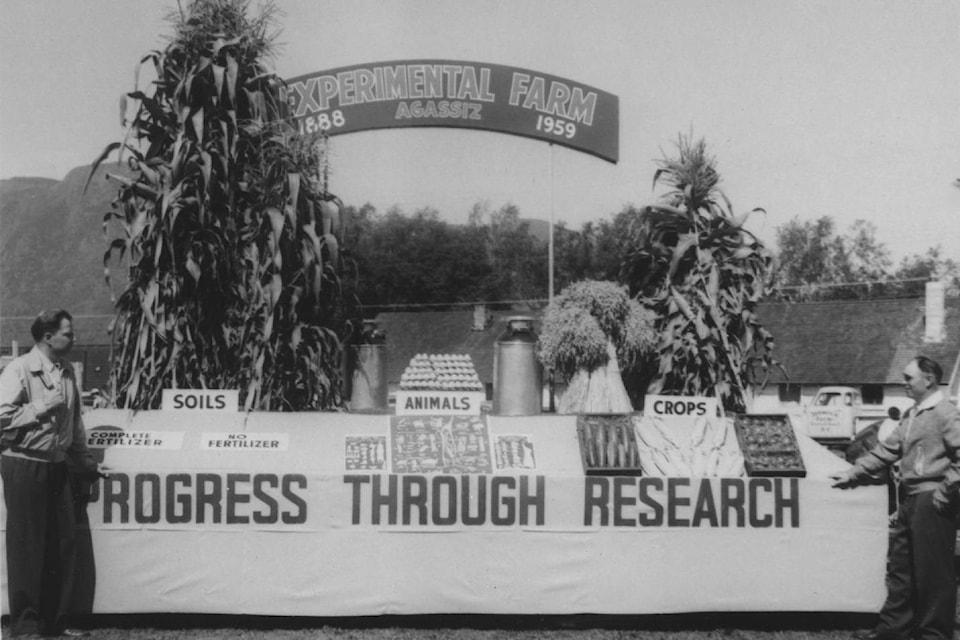The 115th Agassiz Fall Fair and 71st Corn Festival is just around the corner – have you picked up your tickets and planned your entries yet?
RELATED: 114th year of the Agassiz Fall Fair – Video and Photos
Given that I spent much of the summer researching the stone barn at the Agassiz Research and Development Centre, one of two recognized heritage places within the Agassiz-Harrison Valley, I thought that this month’s column would be a great opportunity to look at the relationship between the Research Centre and the Fall Fair.
Did you know that the Fall Fair has taken place within our community almost consistently since 1901? The exception years include WWII (i.e., a few of the years between 1939 and 1945) and the flood of 1948. A picnic was held at the Agassiz Research Centre on September 15, 1948 given that many crops were ruined or delayed as a result of the flood waters and silt deposits.
RELATED: Agassiz’s Fall Fairs: Past and Present
The Agassiz Research Centre (also known as the Agassiz Experimental Farm or Agassiz Research Station), is one of five farms established between 1887 and 1888, following the 1886 enactment of An Act Respecting Experimental Farm Stations.
(The other four farms are located in Brandon, Manitoba; Indian Head, Saskatchewan; Nappan, Nova Scotia; and Ottawa, Ontario.)
| The Agassiz Research and Development Centre at 6947 Hwy 7, late 1800s. The stone barn, built in 1892 and one of two protected heritage structures within the Agassiz-Harrison Valley, is located near the centre of the image. (Agassiz-Harrison Historical Society) |
This facility, and its old stone barn specifically, are intimately tied to our community. The Research Centre is centrally located within the District of Kent, and as such has long served as an important meeting place for community members within our rural, agricultural landscape. The early development of the stone barn, constructed in 1892, and other facilities at the Research Centre provided necessary gathering space for — and resources to support — a variety of annual events, including the Agassiz Fall Fair and Corn Festival, competitive ploughing matches, picnics, banquets and dances.
The Research Centre has been heavily involved with the Fall Fair since its inception. Its participation has included: entry of livestock and crops, judging of livestock and crops, educational agricultural talks and exhibits, development of a parade float, provision of horse teams for pulling parade floats, hosting the associated Fair picnic, and assistance in organizing and chairing the event. Research Centre staff work very closely with Agassiz Agricultural and Horticultural Association members to organize and execute the Fair and Festival each year.
| Grassland Field Day, circa 1950. (Agassiz-Harrison Historical Society) |
And why wouldn’t they take the opportunity to showcase their research? The rich soils, temperate environment and long growing season within the Agassiz-Harrison Valley has enabled Research Centre staff to develop new varieties of grain, strawberry and raspberry. Further, the twentieth century emphasis on livestock research resulted in award-winning Holstein-Friesians (butterfat production), Clydesdale horses (ploughing competitions) and hens (record egg laying).
RELATED: Dozens share in Agassiz history at first-ever Heritage Speaker Night
In fact, in 1923, the superintendent of the farm, W.H. Hicks, held a banquet and dance in honour of “The World’s Champion Cow” Segis May Echo, complete with a programme listing the toasts by local dignitaries and the six-course menu!
We would love to hear your memories of both the Agassiz Research Centre and the Agassiz Fall Fair and Corn Festival.
How has the Fair and Festival changed over time? How does the community’s current relationship with the Research Centre compare to the past? How can we ensure that the story of this unique facility continues to be shared with current and future generations within the Agassiz-Harrison Valley? Please feel free to contact us at agassizharrisonmuseum@shawbiz.ca or 604-796-3545.
news@ahobserver.com
Like us on Facebook and follow us on Twitter
